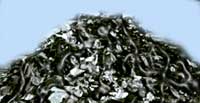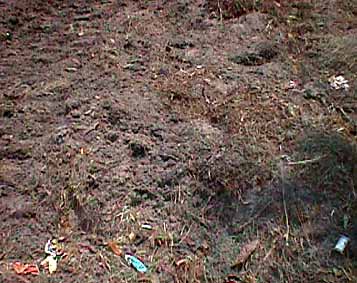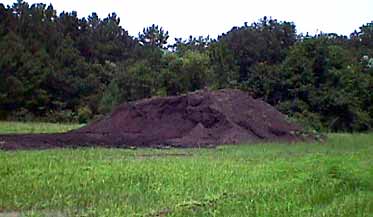Sweeping Debris Disposal

Sweeping Debris Disposal |
 |
Georgia City Finds Innovative Solution for Disposal of Sweeping WastesBy John BeallCoping With Environmental ChallengesThe City of Hinesville is one of the fastest growing cities in southeast Georgia. It boasts a population of approximately 30,000. The impetus for this growth is Fort Stewart, a military base housing the U.S. Army's 3rd Infantry Division. As with other states, there is a growing demand to curb landfill disposal of yard wastes, old tires, sewage sludge and street sweepings. The Georgia Environmental Protection Division (EPD) mandated a 25% reduction in landfill loadings by users. The City of Hinesville initiated a series of moves to attain compliance. A recycling program was begun, however it was soon apparent that urging people to recycle aluminum cans and plastic bottles would never approach the mandated 25% reduction in landfill wastes.
All yard wastes destined for the landfill were diverted to a selected ten-acre site at the western end of the city. The yard wastes are transported by truck to the site and offloaded on the working face of the site for further processing. Raw materials consist of trees (cut into approximate four-foot sections), limbs, grass clippings, leaves, pine straw, and other yard-type wastes. Most grass clippings are received from homeowners in plastic bags.
After delivery to the JV Road site an OMI site operator sifts through all the material and removes all plastic, garbage, paper or other items that should be excluded from the mulch. These are placed into a dumpster for sanitary landfill disposal.
Raw materials are moved around the site by use of a track loader. This type of equipment is a necessity during Georgia's seasons of moderate-to-heavy rainfall which, incidentally, coincides with the periods of heaviest collection of yard wastes. For security reasons, the entire area is fenced to prevent unauthorized entry. The OMI employees pile a small quantity of mulch outside the fence for collection by citizens during hours when the site is closed. Twice each year a grinder is acquired to reduce the raw material to a manageable consistency. As the raw material is ground, a coarse blend is discharged from the chute. The material is windrowed and turned on a bi-monthly frequency to complete the decay cycle. Since very high temperatures are attained during this process, it is essential that fire fighting equipment and dirt are close by to extinguish any flame, and the staff has adequate knowledge of how to handle a blaze. 
After six-to-eight months, a trommel screen with a mesh of less than one inch is delivered to the site for further processing the mulch. The more coarse material is removed from the pile to be used as boiler fuel, and is given to anyone in the community to be used for this purpose. The Finished ProductAs shown in the photograph, the finished mulch product is a fine, grainy material with high density. Currently the city provides the mulch to its residents at no charge. The mulching process, though time-consuming, produces a desirable end product. Mulch is an excellent material for providing moisture and protection to various horticulture plants, including flowers and trees. The University of Georgia Cooperative Extension Service has indicated mulch from yard wastes is extremely effective for increasing production of pecans and other plants. 
The process is a success, working well for the City of Hinesville and OMI. However, it wasn't long before a new wrinkle was added. Hinesville, as many other locales have done in the past, transported street sweepings to a sanitary or inert landfill for disposal. OMI is responsible for sweeping the city streets weekly. This frequency of street sweepings significantly reduces the possibility of accumulations of toxic or other compounds that could cause a detrimental effect on disposal of the street sweepings, the mulching process, or ultimate use of the finished product. When the Georgia EPD directed the city to begin transporting all street-sweeping wastes to a sanitary landfill for disposal, OMI began to search for alternatives. Through a literature search it was learned that numerous other municipal and county governments had been faced with similar prospects. However, most of the recycling efforts found were in environments dissimilar to those found in southeast Georgia. OMI had to find a Georgia solution. Through the ingenuity of OMI personnel, an alternative was found. However, the EPD had to approve any plan that called for deviating from transporting the street sweepings to a sanitary landfill. Samples were taken of the street sweepings for analyses. As expected, all parameters, with the exception of total Cresol (including TPH and BTEX), were found to be below detection limits. Fortunately, the total Cresol had a reading well below EPA and Georgia EPD allowable limits. The proposal was made and the EPD agreed. The agency further determined that all street sweepings could be stockpiled at the JV Road site for up to six months. Then, whenever the trommel screen was scheduled for screening the mulch, the street sweepings would be screened and the resulting material would then be integrated into the mulch. Anything screened out would be placed in the onsite dumpster for transport to the landfill. A testing requirement of twice per year was mandated, in order to monitor any change in characteristics of the street sweepings. By eliminating the street sweeping waste stream from the landfill, the city now can claim a 27% reduction in their loading to the landfill. This will not only save significant revenue from tipping fees, but it will also extend the usable life of the landfill. The process that has been employed is shown in the diagram below. No change has been required in the mulching operation, with the exception of the addition of the new waste stream of street sweepings. This example serves as proof positive that there are solutions available to our environmental challenges. In our case, the goals were achieved by forging an innovative partnership between regulators and the regulated public. Our community has proven that the desired goal of reducing the landfill waste stream -- while at the same time maintaining a safe, healthy environment -- can become a reality.
|
© 2005 - 2024 World Sweeper
|
Sweeping Disposal Contents
|